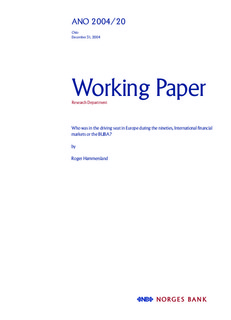| dc.contributor.author | Hammersland, Roger | |
| dc.date.accessioned | 2018-05-18T10:04:58Z | |
| dc.date.available | 2018-05-18T10:04:58Z | |
| dc.date.issued | 2004 | |
| dc.identifier.isbn | 82-7553-278-7 | |
| dc.identifier.isbn | 82-7553-279-5 | |
| dc.identifier.issn | 0801-2504 | |
| dc.identifier.issn | 1502-8143 | |
| dc.identifier.uri | http://hdl.handle.net/11250/2498532 | |
| dc.description.abstract | The purpose of this paper is to reexamine empirically the relationship between long-term interest rates in well integrated financial markets. The analysis focuses on long-term interest rates in the US and Germany and has been carried out within the framework of a five dimensional VAR for the simultaneous determination of short- and long-term interest rates in the US and Germany and the rate of exchange rate depreciation. The results strongly support the existence of a long-run relationship between the long-term German and the long-term US interest rate and imply a full pass-through of changes in the long-term US rate into the corresponding German rate. The analysis also substantiates that the direction of causality goes from the long-term US to the long-term German interest rate. With regard to the possibility of controlling the long end of the market on the part of the Bundesbank, the paper apparently takes on a rather pessimistic view, as there is nothing to indicate a long-run relationship between short-and long-term German interest rates. However, the strong influence that short-term German interest rates exhibit on German long-term interest rates in the very short run according to the structural model of this paper, might be taken to indicate that the opposite is the case, as effects originating from expectations of future short-term interest rates might totally neutralize an unequivocally positive short-run portfolio effect in the long run. If this is the case, there is nothing strange to the fact that one is unable to identify a long-run relationship between short- and long-term German interest rates. On the contrary, it is exactly what to be expected if the monetary transmission mechanism works appropriately. | nb_NO |
| dc.language.iso | eng | nb_NO |
| dc.publisher | Norges Bank | nb_NO |
| dc.relation.ispartofseries | Working Papers;20/2004 | |
| dc.rights | Attribution-NonCommercial-NoDerivatives 4.0 Internasjonal | * |
| dc.rights.uri | http://creativecommons.org/licenses/by-nc-nd/4.0/deed.no | * |
| dc.subject | JEL: C32 | nb_NO |
| dc.subject | JEL: E43 | nb_NO |
| dc.subject | JEL: E52 | nb_NO |
| dc.subject | JEL: E58 | nb_NO |
| dc.subject | cointegration | nb_NO |
| dc.subject | simultaneous equation models | nb_NO |
| dc.subject | international interest rate linkages | nb_NO |
| dc.subject | transmission mechanism | nb_NO |
| dc.title | Who Was in the Driving Seat in Europe During the Nineties, International Financial Markets or the BUBA? | nb_NO |
| dc.type | Working paper | nb_NO |
| dc.description.version | publishedVersion | nb_NO |
| dc.subject.nsi | VDP::Samfunnsvitenskap: 200::Økonomi: 210::Samfunnsøkonomi: 212 | nb_NO |
| dc.source.pagenumber | 35 | nb_NO |

